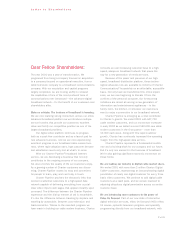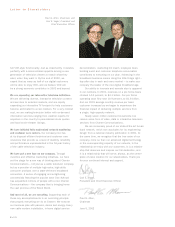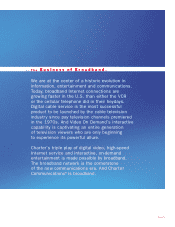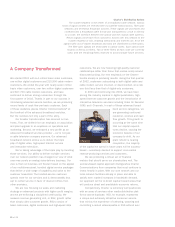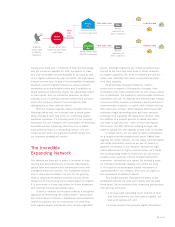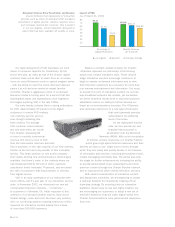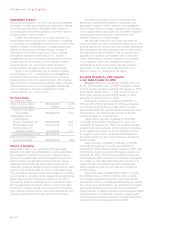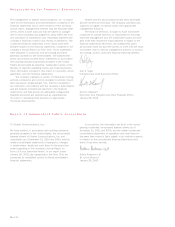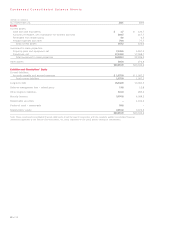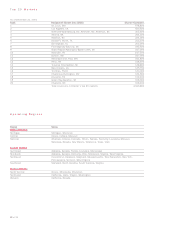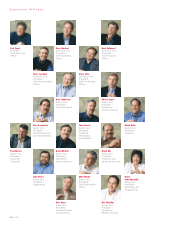Charter 2001 Annual Report Download - page 19
Download and view the complete annual report
Please find page 19 of the 2001 Charter annual report below. You can navigate through the pages in the report by either clicking on the pages listed below, or by using the keyword search tool below to find specific information within the annual report.
17 of 25
Operating, General and Administrative Expenses.
Operating, general and administrative expenses increased
by $458.7 million, or 27.8%, from $1,651.3 million in 2000
to $2,110.0 million in 2001. System operations acquired
after January 1, 2000 accounted for $288.5 million, or
63%, of the increase in 2001 while systems acquired before
January 1, 2000 accounted for $170.2 million, or 37%.
The increase in general, administrative and service
costs of $142.1 million, or 19.7%, resulted from increased
bad debt expense of $48.6 million associated with discounted
analog video customer disconnects, coupled with increased
spending on customer care and overall continued growth. The
increase in analog video programming costs of $166.8 million,
or 22.7%, was primarily the result of continued inflationary
or negotiated increases, primarily in sports programming,
coupled with increased channel offerings. The increase of
$75.0 million, or 207.2%, in direct operating costs to provide
digital video services resulted primarily from internal growth
of these advanced services. The increase of $60.8 million,
or 155.1%, in direct operating costs to provide cable modem
services resulted primarily from internal growth. Advertising
sales costs increased $7.5 million, or 13.3%, primarily in
association with costs related to an increased level of
advertising purchased by programmers. Marketing expenses
increased $6.5 million, or 10.2%, related to an increased
level of promotions of our service offerings.
Gross Margin. Gross margin (defined as revenues less
operating, general and administrative expenses divided by
revenues) decreased from 49.2% in 2000 to 46.6% in 2001,
primarily resulting from the acquisition of less profitable cable
systems from AT&T Broadband. Analog video gross margin
decreased from 70.6% in 2000 to 67.6% in 2001, primarily
resulting from such acquisitions coupled with continued infla-
tion and negotiated increases in programming costs. Digital
video gross margin increased from 59.5% in 2000 to 63.8%
in 2001, primarily resulting from economies of scale created
by an increased customer base. Cable modem gross margin
increased from 28.3% in 2000 to 35.2% in 2001 resulting
from economies of scale created by an increased customer
base. Advertising sales gross margin increased from 75.9%
in 2000 to 79.5% in 2001 resulting from expanded channel
capacity as a result of our system upgrades, coupled with
increased advertising purchases by programmers.
Special Charges. Special charges of $17.6 million
represent charges associated with the transition of approx-
imately 145,000 data customers from the Excite@Home
Internet service to our Charter Pipeline®service, as well
as employee severance costs. These charges included
$14.3 million in operational expenses in connection with
the transition, including a one-time contract payment of
$1.0 million to Excite@Home for the provision of services
through February 2002 to the 10% of customers that would
not be transitioned by December 31, 2001; and severance
costs of $3.3 million associated with the termination of
approximately 360 employees.
Minority Interest in Loss of Subsidiary. Minority interest
in loss of subsidiary increased by $251.9 million, or 20.5%,
from $1,226.3 million in 2000 to $1,478.2 million in 2001.
Minority interest in loss of subsidiary represents the allocation
of losses to the minority interest which is based on ownership
of Charter Communications Holding Company and the 2%
accretion of the preferred membership units in an indirect
subsidiary of Charter Holdings issued to certain Bresnan
sellers. These membership units are exchangeable on a one-
for-one basis for shares of Class A common stock of Charter
Communications, Inc. The increase is a result of an increase
in loss before minority interest offset by a decrease in the
minority interest percentage as a result of the issuance of
Class A common stock by Charter Communications, Inc.
Capital Expenditures
We have substantial ongoing capital expenditure require-
ments. We make capital expenditures primarily to upgrade,
rebuild and expand our cable systems, develop new
products and services, and deploy digital converters and
cable modems. Upgrading our cable systems will enable
us to offer an increasing variety of advanced products
and services, including digital television, cable modem
high-speed Internet access, Video On Demand, interactive
services, additional channels and expanded pay-per-view
options, to a larger customer base.
We made capital expenditures, excluding acquisitions of
cable systems of $3.0 billion, $2.8 billion and $741.5 million
for the years ended December 31, 2001, 2000 and 1999,
respectively. The majority of the capital expenditures in 2001
related to our rebuild and upgrade program and purchases of
converters and cable modems, and were funded from cash
flows from operations, the issuance of debt, borrowings under
credit facilities and the issuance of Class A common stock.
In 2002, we expect to spend a total of approximately
$2.5 billion, including expenditures to upgrade and rebuild
our systems in order to offer advanced services to our
customers and normal recurring capital expenditures.
Normal recurring capital expenditures will include extensions
of systems, development of new products and services,
purchases of converters and cable modems, system improve-
ments and the construction of advanced customer contact
centers. The actual amount that we spend on these types
of capital expenditures will depend on the level of growth in
our digital cable customer base and in the delivery of other
advanced services. We currently anticipate that we will have
sufficient capital to fund our capital expenditures until the
point at which we expect cash flows from operations to
fund our capital expenditures and interest expense.


